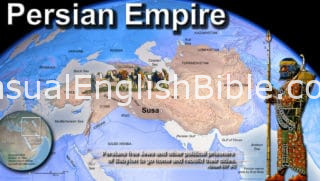INTRO NOTES TO NEHEMIAH
Nehemiah is one odd story. He’s a Jew serving wine to a Persian king in what is now Iran. Who saw that coming?
The king, Artaxerxes, trusts this Jewish man with his life.
How did Nehemiah get there? Likely he was the descendant of Jews taken captive to Babylon (Iraq) about 150 years earlier, when Babylon leveled Jerusalem and other cities and took the Jews captive.
About 50 years later, Persia (Iran) defeated Babylon and freed the Jews and other captives to go home. But many Jews stayed because they grew up in exile. Iraq and Iran was the only homeland they knew. Yet, many returned to the land of their ancestors to rebuild Jerusalem and the other cities.
Nehemiah gets word that Jerusalem’s walls are still broken down and the city gates are gone. It’s a city undefended. He can’t believe it. By this time, Jews have had about 90 years to fix those walls.
Winetaster becomes city builder
So, Nehemiah talks the king into giving him a 12-year leave of absence so he can repair the walls. It certainly seems odd that the king would grant his winetaster’s Big Ask. Yet the king also agrees to give him the wood for the job, sends him with a detachment of soldiers as an escort, and then appoints him governor over the Jewish province of Judah.
That’s what the southern Jewish nation of Judah had become, a Persian province ruled by a Persian king who even chose the songs Jews could sing at the Temple (Nehemiah 11:23).
Earlier, when Babylon exiled Jews from their homeland, settlers moved in. They hated the idea of Jews returning to power because it meant the Jews would try to take back the land and get rid of everyone else.
Nehemiah had 12 years to fix the walls. It took him 52 days.
Nehemiah rallied Jerusalem-area Jews to join the work. They felt the clock sands slipping away while their neighbors plotted to stop the work. Murdering Nehemiah seems to have been one plan on the table. Attacking the work crew was another.
Jewish construction workers carried their weapons on the job in daylight, guarded the walls all night, and didn’t get much sleep during those 52 days and nights.
Nehemiah spent the rest of his 12-year leave reminding the people what it meant to be Jewish. They studied the Laws of Moses that we read today as the first five books in the Bible.
Misbehaving Jewish priests
Nehemiah returned to Persia perhaps because his leave was up or for the annual celebration of the king’s coronation day. But he came back, apparently to deal with misbehaving Jews.
He dealt with corruption among the priests. He even banished a son of the high priest. Then he prayed for the man’s family:
“God above, remember that rotten family. They stink up the priesthood and spit on the covenant of their ministry as priests and Levites” (Nehemiah 13:29).
He convinced the Jewish to people renew their vows to God and reminded them of how to behave.
Once, he got ranting, face-slapping, hair-pulling mad about Jewish men marrying non-Jews. He insisted that Jews marry Jews. Nehemiah said, “I made them swear an oath: ‘I will not let my sons and daughters marry foreigners. Period” (Nehemiah 13:25).
He told the people that marriages with foreigners are what got the Jewish nations erased. Jews married outsiders and started living like outsiders, ignoring God and worshiping idols.
He didn’t want the Jews to fall into that trap again. Neither did a priest named Ezra, whose story appears in the Bible Book of Ezra, just in front of Nehemiah’s story.
For a time, the two seemed to work as a tag team that took on all offenders of the Laws of Moses.
Writer
“I’m Nehemiah, Hacaliah’s son. And this is my story” (Nehemiah 1:1). The books of Ezra and Nehemiah were originally one book. Ezra’s book has no byline and Nehemiah is written in the first person, as his personal memoire.
Jewish tradition says Ezra wrote his story and added Nehemiah’s at the end.
Together, the books followed stories from the early history of Israel, preserved in 1 and 2 Chronicles, which were originally one book as well.
Timeline
586 BC, Babylon levels Jerusalem, takes Jewish captives to Babylon
539 BC, Babylon surrenders to Persians
538 BC, Persians free Jews and other captives
516 BC, Jews finish rebuilding Temple
458 BC, Ezra arrives
446 BC, Nehemiah arrives and repairs Jerusalem walls
433 BC, Nehemiah visits Persian king Artaxerxes, returns to Jerusalem
424 BC, Artaxerxes dies of natural causes
408 BC, Egyptian document IDs Sanballat as governor of Samaria
Nehemiah’s story starts in about 446 BC. That’s close to 150 years after Babylonian invaders from what is now Iraq leveled Jerusalem and exiled Jews who survived the war. It’s also about 90 years after Jews started returning to rebuild their cities.
Nehemiah spent about a dozen years serving as Judah’s governor. He went back to Persia, but was sent back to Judah a second time, apparently because some important Jews were abusing their power.
Location
Four stops: Persian capital city of Susa, then to Jerusalem, back to Susa, and back to Jerusalem.
Nehemiah’s story starts in the palace of the Persian king, in Susa—now Shush, Iran. The story quickly shifts to Jerusalem, roughly a thousand miles away (1,600 km). There, repairs the city’s broken walls. About a dozen years later he goes back to see the king, perhaps because his leave is up or to celebrate the king’s 32nd year on the throne. But he gets sent back to Jerusalem, perhaps on a mission to clean up the corruption caused by the high priest.
Purpose
Nehemiah’s memoires tell how he led Jerusalem-area Jews on a miraculous, 52-day marathon construction job: repairing Jerusalem’s walls and rebuilding the gates.
With the walls built, he picked a new project. As he put it:
“I cleaned up that town. I got rid of everything that wasn’t kosher” (Nehemiah 13:30).
He forced the Jews to stop buying and selling on the Sabbath; he closed the city gates during Sabbath, so merchants couldn’t come in.
He appointed honest Jews as Temple treasurers. The high priest had been hoarding the grain, wine, and other donated items instead of sharing them with Temple workers as their salary. Jewish law said Temple workers share what is donated.
That put the Temple workers back on the job. They had started working on farms to make a living. So, Temple singers were making music again, Guards stood at the gates. And Jews were again bringing their donations and sacrifices to the Temple.
Jerusalem was looking Jewish again.
Nehemiah ended his memoire with a prayer:
“Don’t forget who I am, God. Remember the good parts of my life” (Nehemiah 13:31).
Who can’t warm up to a prayer like that?





